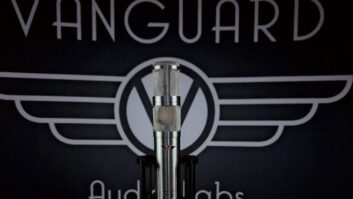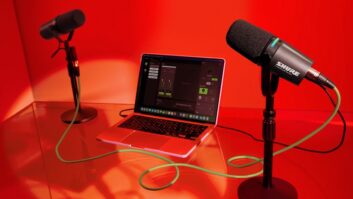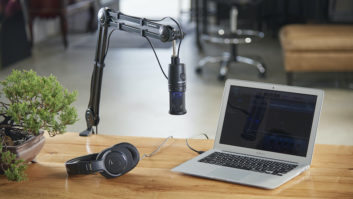
While the rest of the world is at play, it seems that the Swedes are spending their long, cold winters pushing microphone technology in new directions. Though rectangular capsules are nothing new — Sweden’s Pearl and Milab are the only companies making them — a capsule with such a large surface area is. The spin on this interesting capsule design is that it is said to offer many benefits over the time-tested circular diaphragm.
ANATOMY OF AN UNUSUAL MIC
According to the manufacturer, the traditional circular capsule design carries a flaw: Its primary resonance can be sonically detrimental, especially when it resides in the audible range. Damping can help, but it does not eliminate the problem. Larger capsules improve signal-to-noise but add to the problem by lowering resonance further into the audible range. The ELM-C’s rectangular capsule greatly reduces resonance while adding more than double the surface area of its circular brother, thus improving the signal-to-noise spec (10 dBA).
Other benefits of the 7:1 length-to-width capsule ratio include more high-frequency linearity across the very wide horizontal axis and more rejection above and below the mic where floor and ceiling interaction can be a problem.
The mic comes in a sturdy aluminum box with a snug-form insert. Each mic is tested separately, and the frequency response chart is tucked neatly below the mic. Response is nearly flat from 20 to 20k Hz, and the mic can handle 126dB SPL before distortion. Each mic has an LED mounted inside that glows brightly when phantom power is introduced — a very nice confidence monitor. An optional stereo bar and shock-mount are available.
ON THE JOB
The science and theories explained above are impressive, but how does the mic sound? The answer is equally impressive. I had a pair of ELM-Cs with the optional stereo bar and shock-mounts for this test and was able to hear them in a wide variety of applications. First, I used them as drum overheads. Due to the unusual horizontal and vertical linearity and rejection characteristics, I wanted to place them both top-to-top and side-by-side to hear the difference. This procedure was impossible to accomplish with the stereo bar — one of the few gripes I have about the product. Calling this rig clunky would be a compliment.
I found the best way to use the mics was to forgo the supplied mount and instead use an Audio-Technica spring-clip mount. The two-pair configurations each had their own personality and provided subtle differences in the stereo picture. It’s something new to be able to “play” the room by putting problem areas off the mic’s vertical axis.
The pair worked equally well as room mics and knee-highs. I used them to capture room ambience in many applications with great results. For instance, the mics shined when used to give a larger picture to percussion, trumpet and a drum kit.
Although the ELM-C sounded great on most recordings carried out for this test, it was simply awesome when used in stereo on a Yamaha C3 grand piano. The mics were placed about a foot over the strings and provided a beautiful rendition of the C3’s brightness and body. Even when the player hit it hard, the ELM-3s hung in there. ELM-C + Piano = A Love Thang!
Next, I tried the pair on a small brass ensemble, comparing them against a pair of Neumann U87s. The Pearls were noticeably brighter on the top and gave a very nice picture of the room. The stereo picture was beautifully rendered. Surprisingly, the mic was underwhelming when used in mono on a tenor sax. The Pearl simply did not flatter the tenor sax, bringing out the upper mids disproportionately. When used against a Neumann M147 tube mic, the Neumann easily won.
The mics sounded good when used to record percussion up close. They didn’t sound as open and had less top than a pair of DPA 4061s, but they hung in nonetheless and took well to being brightened at the top with a bit of EQ.
The wide cardioid pattern and even off-axis response were proven when the ELM-C was used in mono on an acoustic guitar. A single mic rendered a balanced picture of the guitar, even though it was placed near where the neck meets the body, an area that usually sounds thin. It also sounded very good when put in front of a guitar amp. It handled all the level the amp could give, never breaking up.
Last, I used the mic on a vocal. I really didn’t know what to expect and it didn’t disappoint. It did a journeyman job against a U87 and a DPA 4061, providing some nice top without being strident and sat nicely in the mix. Although it wouldn’t be my first-call vocal mic, it wasn’t bad.
A MIC FOR EVERY JOB?
Asking a mic to be the be-all, end-all transducer is unfair, but I found the Pearl to be versatile, delivering usable tracks in a variety of applications. My favorite application was as a stereo pair on piano; this seems to be why this mic was born. The sound from top to bottom and the stereo picture were stunning. One of my favorite aspects of this mic was that thanks to the capsule’s natural directivity, I could use placement to de-accentuate unflattering parts of the room, such as floor and ceiling reflections.
My only disappointments were the less-than-stellar results recording tenor sax and the far-from-useful stereo bar and shock-mounts. Other than that, I’d highly recommend the Pearl ELM-C, especially as a stereo pair for high-end room, piano and orchestral applications. Price: $2,000.
Pearl, dist. in the U.S. by Independent Audio, 207/773-2424, www.independentaudio.com.







